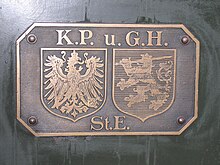Prussian-Hessian Railway Community
The Prussian-Hessian Railway Community (with full name: Königlich Prussische und Großherzoglich Hessische Eisenbahnbetriebs- und Finanzgemeinschaft ) was the joint operation of the Royal Prussian and Grand Ducal Hessian State Railways . The Hessian part of the community was operated by the Mainz Railway Directorate, which was specially founded for this purpose .
Emergence
The reason for this merger was, on the one hand, the geographical location of the two-part Grand Duchy of Hesse, which was closely nested with Prussian areas. On the other hand, both states had the goal of nationalizing the last large private railway in Germany, the Hessische Ludwigs-Eisenbahngesellschaft (HLB). The two states signed a treaty on this project on June 23, 1896 .
On April 1, 1897, the administration of the Prussian State Railways took over the management of the State Railways of the Grand Duchy of Hesse under the common name of the Royal Prussian and Grand Ducal Hessian Railway Operating and Financial Community . Property rights and sovereign rights as well as the proportional return remained with the Grand Duchy of Hesse in accordance with the State Treaty. The Royal Prussian and Grand Ducal Hessian Railway Directorate in Mainz was founded to manage the railway community , with Paul von Breitenbach becoming its president . On April 8, 1899, employees were prohibited from wearing HLB uniforms.
On December 14, 1901, the Kingdom of Prussia, the Grand Duchy of Hesse and the Grand Duchy of Baden signed a state treaty with which the Main-Neckar Railway, previously operated by the three states, was also incorporated into the Prussian-Hessian Railway Community.
business
It was also agreed that Hessen could influence the filling of the senior civil servant positions. On the other hand, the technology and operations corresponded solely to Prussian regulations. All officials wore the Prussian uniform , but the Hessian officials were also allowed to wear a Hessian badge. The spelling of the station names also became Prussian. This is still noticeable today because the two states used different spelling rules . In the Kingdom of Prussia , place and administrative district names were given a distinctive prefix such as "Alt", "Neu", "Groß", "Klein", "Bergisch", "Deutsch" etc. - provided they were not written in one word - without a hyphen , Place names that are composed of two or more stem names, such as Schleswig-Holstein, Beeskow-Storkow etc. written with a hyphen. In Hessen-Darmstadt, on the other hand, a hyphen was used in the first case group and the word components were written together in the second. To this day, this means that the spelling of the place name and the station name differ from one another in the corresponding places, such as Groß Gerau / Groß-Gerau or Hohensülzen / Hohen-Sülzen .
The End
The Prussian-Hessian Railway Community ended with the transition of the state railways to the German Reichseisenbahnen on April 1, 1920. Even in anticipation, from August 1919 onwards, new railway vehicles were not labeled with the emblem of the Prussian-Hessian state railways.
literature
in alphabetical order by authors / editors
- M. Biermer: The Prussian-Hessian Railway Community = collection of economic essays and lectures in an unconstrained sequence 2, Issue 8. Giessen 1911.
- Grand Ducal Ministry of Finance (ed.): The Hessian Railways in the Prussian-Hessian Railway Operating and Finance Association from April 1, 1897 to March 31, 1907 (memorandum) = Parliamentary Printed Paper No. 732 for the 23rd Parliament in 1905 –1908 of the Grand Duchy of Hesse, Second Chamber. Darmstadt 1908.
- Bernhard Hager: "Absorption by Prussia" or "Benefit for Hesse"? The Prussian-Hessian Railway Community from 1896/97. In: Andreas Hedwig (Ed.): “On iron rails, as fast as lightning”. Regional and supraregional aspects of railway history (= writings of the Hessian State Archives Marburg. Vol. 19). Hessisches Staatsarchiv, Marburg 2008, ISBN 978-3-88964-196-0 , pp. 81–111.
Individual evidence
- ↑ Printed in: Eisenbahndirektion Mainz (Hrsg.): Collection of the published official gazettes . Born 1897, No. 8, p. 29ff: State Treaty on the Joint Management of Mutual Railway Ownership.
- ^ Chronicle of the Mainz Railway Directorate
- ↑ Zentralblatt der Bauverwaltung, Volume 50, 1930, No. 11 (from March 19, 1930), p. 227
- ↑ Eisenbahndirektion Mainz (Ed.): Collection of the published official gazettes of April 8, 1899. Volume 3, No. 16. Announcement No. 170, p. 113.
- ↑ Helmut Schmidt: German Railway Directorates. Basics I: Development of the Directorates 1835-1945. Berlin 2008. ISBN 978-3-933254-85-6 , p. 49.
- ↑ See for example: Renumbering [sic] and redrawing of passenger and baggage cars . In: Eisenbahndirektion Mainz (Hrsg.): Collection of the published official gazettes . Born 1897, announcement no. 175, p. 375.
- ^ Rolf Jehke: Territorial changes in Germany and German administered areas 1874-1945. Section Wolfhagen district , footnote 1
- ↑ http://wiki-de.genealogy.net/Schlesien/Geschichte
- ^ Reichsgesetzblatt 1920, page 773 ff
- ↑ Prussian and Hessian Railway Directorate in Mainz (ed.): Official Gazette of the Prussian and Hessian Railway Directorate in Mainz of August 30, 1919, No. 43. Announcement No. 575, p. 288.
